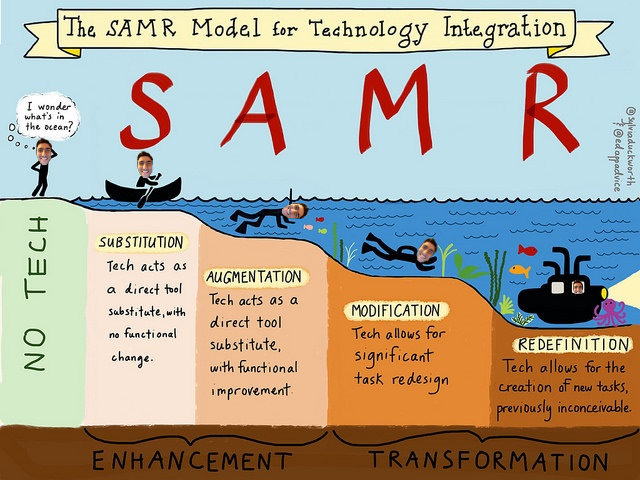Hello dear readers! Welcome to my reflections on my pod’s recent presentation, which took place on the 24th of November, 2023. It is with great pleasure that I memorialzie this experience, as both the research presented and the teamwork that facilitated it left me with a lot of helpful knowledge pertaining to the implementation of SAMR in my future classrooms.
In our modern world, technology is present in many of our daily experiences. It’s become commonplace to always have access to the internet, and assignments that used to rely on paper and tactile tools have been speedily replaced in schools by screens. I watched the progression of this during my own education, from having rare treats where our class would visit the computer lab in elementary school to high school, where each of our classrooms had access to at least two computers. Nowadays, the Chromebooks are wheeled around the school in carts, and there can be multiple class sets, meaning teachers can plan for students to accomplish assignments using these devices. In the high school I volunteered in, every week featured a battle between the teachers to sign up for the Chromebooks, because every teacher wanted to get in with the students by letting them use these tools. They’re versatile for many subjects; their best incorporation, however, can be found when teachers take the time to design meaningful and relevant tasks that utilize the further advantages within this medium and use it to improve the learning process for students. On the higher levels of SAMR, technology can actually diversify the rules of students and redefine established practices like quizzes and exams by giving learners new and more effective ways to demonstrate their learning.
My group spoke about the benefits of technology being successfully integrated into the class, namely its ability to encourage creativity, innovation, and insight in learners. These skills are prioritized within the core competencies of our new curriculum, so the innate opportunities made possible through computers no longer restrict students to demonstrating their learning in only one way. For example, we’ve been writing short stories in English classes since I could remember. Writing is a great way to teach about narrative, characters and the elements of plot; not every student, however, is enthusiastic about writing. Recently, however, my Multiliteracies class was exposed to Twine, a open-source tool for creating interactive and nonlinear stories. Students can create their own branching narratives and then have others play through them, choosing between a series of options at every branch within the story and shaping their our narrative because of their choices. By having teachers use the principles of SAMR to incorporate this tool effectively, Twine could provide an exciting alternative to text-based narratives and gives adolescents a chance to both enhance their problem-solving skills and express themselves through art.
SAMR does contain some inherent risks; for example, poorly funded schools may not be able to provide adequate technology for the number of students they have, leaving some without these resources. This forces teachers to make difficult decisions regarding equity and who most deserves the augmented learning experience they offer, or whether the inequality of it is grounds enough to scrap the idea of even integrating technology into the classroom. There’s also danger in believing that the redefinition level must be reached every time, because although it demonstrates the most potential in terms of creative processes, sometimes mere substitution or augmentation could work if you are assessing students for a specific skill that is not related to technology. For example, if you instruct students to write a narrative and you are merely creating them based on their vocabulary choice, a simple short story would suffice as a means of assessment, and wishes of meeting higher expectations could unnecessarily overcomplicate the lesson.
In conclusion, I found it really helpful to go back and revisit the principles of SAMR. It is important that we, as educators, consider the value that technology is adding to our classrooms and that we remain cognizant of its impact upon our students and their learning. Here’s a site I found really helpful in terms of understanding the potential of this practice! Check it out!
Credit to Sylvia Duckworth’s Sketchnote of SAMR in the Ocean for the SAMR image and thanks to Calissa for editing Sam’s face into it! Thanks to my entire group for their effort and collaboration in this project, y’all are legends. And of course, special thanks to Sam for letting us make him the face (quite literally) of our project!

Leave a Reply
You must be logged in to post a comment.